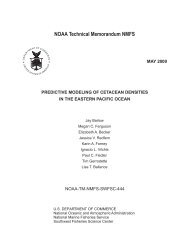NOAA Technical Memorandum NMFS - Southwest Fisheries ...
NOAA Technical Memorandum NMFS - Southwest Fisheries ...
NOAA Technical Memorandum NMFS - Southwest Fisheries ...
You also want an ePaper? Increase the reach of your titles
YUMPU automatically turns print PDFs into web optimized ePapers that Google loves.
While it is possible that these species have a lower vocal rate (and therefore a decreased<br />
acoustic detection rate), we are unable to test this with our data. In fact, we wish to<br />
clarify that the low detection of these species in our study may be a significant bias of our<br />
study methods, and does not imply that they vocalize at a lower rate.<br />
Overall, our results suggest that passive acoustic detection methods can play an<br />
important role in shipboard population and mitigation and monitoring surveys of tropical<br />
and sub-tropical dolphins. Passive acoustic surveys will require information on the vocal<br />
behaviors and rates of each species, acoustic detection of these vocalizations, species<br />
identification based on vocalizations, and group size information. The data presented<br />
here will provide valuable baseline information on both the vocal behavior and acoustic<br />
detection of many cetacean species in the eastern and central Pacific Ocean.<br />
Data on dolphin vocalizations from these surveys has been used to create a<br />
whistle-based acoustic species classification program that allows for real-time species<br />
identification that has been used successfully in real-time in the field (ROCCA, Oswald<br />
et al. 2007b). The high correct classification scores provided by ROCCA for acoustic<br />
species identification of P. crassidens (80%, Oswald et al. 2007b) allowed for<br />
incorporation of passive acoustics during the PICEAS cruise. The addition of passive<br />
acoustic methods to line-transect surveys more than doubled the overall detections of P.<br />
crassidens using visual methods alone (Barlow and Rankin 2007). In addition, acoustic<br />
detection provided a means of estimating the fraction of schools missed by the visual<br />
observers. Future improvement on acoustic species identification algorithms for other<br />
species will allow passive acoustics to play an increasingly important role in cetacean<br />
surveys. Independent estimation of abundance using acoustic methods will require a<br />
means of determining group size, which has not yet been accomplished. Nonetheless, the<br />
results from these surveys have demonstrated that passive acoustics detection using a<br />
towed hydrophone array can provide considerable contributions to ship-based cetacean<br />
surveys.<br />
E. Sonobuoy Detections<br />
These SWFSC cetacean surveys have provided numerous opportunities to obtain<br />
sonobuoy recordings of baleen whale and dolphin species in remote regions of the Pacific<br />
Ocean. Only a fraction of the recordings have been analyzed; this subset of data has<br />
resulted in characterizations of calls from several species including B. borealis (Rankin<br />
and Barlow 2007b), B. edeni (Oleson et al. 2003), L. hosei (Oswald et al. 2007a), B.<br />
musculus (Rankin et al. 2006), and E. japonica (Munger 2008). Analysis of the<br />
remainder of these recordings will provide additional information on the vocal repertoire<br />
of these species. For example, there are at least three recordings of a previously<br />
undescribed pulsed vocalization recorded in the presence of B. edeni that have yet to be<br />
analyzed.<br />
In addition to providing a means of recording low frequency sounds, some types<br />
of sonobuoys can provide bearing information to the sound source (e.g. type 53D, 77B).<br />
During the SPLASH survey, sonobuoys were used successfully to detect, localize, and<br />
approach groups of the endangered E. japonica in the Bering Sea (Wade et al. 2006).<br />
While these methods are not typically used during most surveys due to limited personnel<br />
and funding; they can provide a means of detecting, localizing and tracking certain<br />
16









